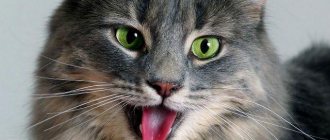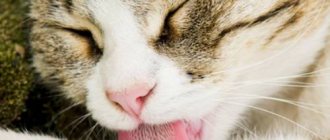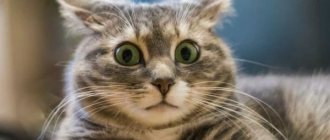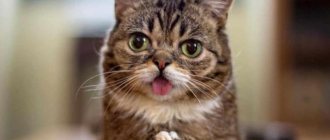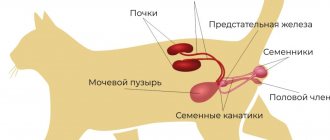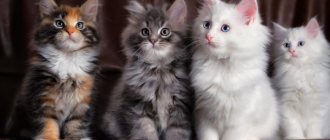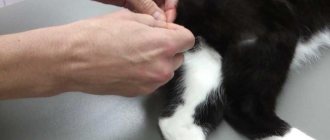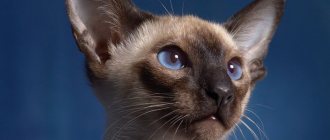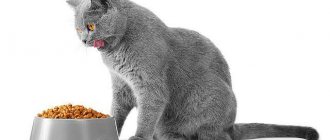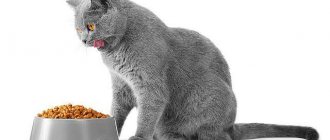Features of the tail structure
The cat's tail is an extension of the spine, so it consists of vertebrae. Depending on the breed, their number reaches 27, while the length of the tail is 40-50 cm. Like the whole body, it is covered with muscle tissue and skin.
Features of the structure of a cat's tail
In tailed breeds it consists of three parts:
- Root. 4-6 fused vertebrae that start from the sacrum.
- Stem. A flexible part of 10-15 elongated vertebrae. Between them are cartilages that connect the joints, which are surrounded by jelly-like intervertebral fluid.
- The tip of the tail. The vertebrae shorten closer to the end and become thinner. The last vertebra does not have connecting cartilage, so it grows in any shape.
The tail is not only a benefit, but also a nuisance
It is known that inattentive owners often step on the tail of a lying cat, and even grumble at the same time. The tail is pulled by children, pinched by a door, and a dog can grab onto it when the cat has almost managed to escape. In a word, the long process behind the body requires careful handling.
Any injuries to the tail are very painful because there are a huge number of nerve endings located there. If the tail is broken, then neither a cast nor an operation is performed; the only way out is amputation. A cat can get a fracture or dislocation due to a sharp tug on its tail.
Wounds in this area heal slowly because the cat will lick and even chew its own tail. You can’t do without a protective collar, but it’s almost impossible to put a bandage on your ponytail - it slips.
Unneutered cats and Sphynx cats also suffer from greasy tail syndrome. The tail contains many glands that produce sebum. When their function is impaired, the skin becomes covered with painful acne, and sometimes pyoderma is observed.
Cats rarely allow their tails to be touched, and owners should not anger their cat by playing with this sensitive part of the body. But young kittens sometimes don’t mind chasing their own tail. In adult cats, increased attention to the tail may indicate nervousness, itching, pain, or numbness (impaired nerve supply) in that area.
Why is it needed?
A cat's tail performs many vital functions:
- keeps balance;
- helps to navigate in space;
- controls the process of thermoregulation;
- as a way of communication;
- one of the health indicators;
- just for beauty and entertainment.
And now in more detail about each point why this organ is needed.
Tail and cat mood
How to determine a cat's mood?
In its natural state, when it is down or wrapped around the paws, a cat's tail signifies calmness. However, they can express a dozen more different emotions! The most common ones are described in the table below.
| Position | Mood |
| Disheveled and drooping | Scared |
| Raised high | Glad to meet you |
| Lowered, mobile | Bad mood |
| Raised with curved tip | Happy, wants to be friends |
| Raised high, agile | Excited, glad to see |
| Pressed down, root raised | Feeling scared or guilty |
| Raised and disheveled | Feeling threatened |
| Curls along the body | In love |
| Sticks out back, tip is turned inward | Shows affection |
A joyful kitten runs towards its owner
What do tail movements mean?
In addition to the position of the tail relative to the body, the cat makes various movements, which can also be used to determine its emotional state:
- a lowered, motionless tail indicates that the pet is disappointed or very tired;
- raised up, when only the tip moves, means joy;
- smooth movements at a medium level show his interest in the situation;
- small amplitude of movement - he is in thought;
- wide scope - sexual attraction;
- a large amplitude combined with the beating of the tail on the floor indicates the cat’s irritation, dissatisfaction, and anger;
- hits the sides, which means he is preparing for a fight.
The tip of the tail rises when the cat is nervous
Tailless animals are limited in emotional communication. They cannot correctly convey their feelings, mood, desire. This is comparable to having fingers for a person who does not speak sign language.
Balancing
Cats need a tail even when hunting.
The cat unconsciously uses this function, since the opportunity is gifted by nature itself. With the help of the tail, you can freely control your body, perform maneuvers during the hunt, and overcome obstacles unimaginable to humans. When a cat falls or jumps from a height, it maintains body balance and helps to take a safe position for landing. This occurs due to free rotation and twitching. It also allows you to maintain balance on turns and narrow surfaces, and acts as a rudder when swimming.
Maintaining balance is the main function of a cat's tail.
And the fan and the blanket
Many people know about this from folk superstitions: a cat curls up into a ball and covers its nose with its tail when cold weather is approaching, and fans itself like a fan when the air temperature is high. Such actions help the animal control its body temperature, raising or lowering it, while the tail is a tool for thermoregulation.
One of the functions of a cat's tail is thermoregulation.
Intimidating enemies
When a cat is seriously frightened, the fur all over the body stands on end, and the tail is fluffed to the maximum, raised high and arched. This pose makes the animal appear larger and scarier than it actually is, which is why many representatives of the animal kingdom resort to such an effective trick to intimidate their enemies.
Even among closely related species, there are rituals that make it possible to determine who is in charge without a fight. So cats will prefer to howl for a long time and terribly, spinning around each other before starting a fight. And a large fluffy tail will help its owner gain the necessary superiority in this matter.
Entertainment
In addition to the important functions described above, the tail can be useful for games. If your pet has few toys nearby or wants to exercise and have fun, he can easily focus on his own tail. Its constant active movements perfectly imitate a potential prey that can be hunted.
What does the tail look like when the kitten is in a playful state?
It is important to understand that the cat knows that the tail is part of its body, and not an enemy or prey. She will never harm herself, so there is no need to worry about it, much less deliberately interfere with play. After playing, as a rule, the animal begins to intensively care for its tail in order to bring it into proper shape.
What do tail movements mean?
Cats give signals by changing the expression of their eyes, the position of their ears and the amplitude of their tail movement.
| Emotions | Tail position | Additional signs |
| Serenity | Quietly hanging or lying down | The animal sits or lies with its front legs bent |
| Anxiety | Lifts up or wobbles from side to side | The pet meows anxiously and presses its ears |
| Irritation | Nervously wobbles or sticks out backwards and upwards | The cat tilts its ears back and swings its paw as if striking |
| Malice | Beats, wobbles, wriggles sharply | The pet meows or growls aggressively and presses its ears to its head |
| Playfulness | Protrudes back and wriggles at the tip | The cat carefully observes what is happening and takes a “ready to attack” pose. |
| Joy | Lifted by a pipe | The cat purrs with squinted eyes |
| Tenderness | Protrudes back with the tip turned inward | The animal purrs and rubs its head, squinting its eyes, stretching and straightening all its paws |
| Happiness | Lifts with a pipe, may shake slightly | The cat purrs with its ears raised up |
| Soreness | Lies or dangles, the tip may wag | The cat meows pitifully, becomes weak and lethargic |
| Love | Rises up and shakes | The cat meows with its eyes wide open |
Is it possible to do without it?
Yard cats very often suffer injuries, as a result of which they lose their tails. Purebred animals practically never go outside and do not climb trees. Therefore, they are extremely rarely injured.
But representatives of certain cat breeds are born bobtailed. For them, this part of the body is not as important as for those who have lost it due to injury or illness. But even without it, pets can live a long life. Having lost their tail, cats learn to express emotions with their paws, meows and eyes and continue to normally jump, run and climb trees.
The influence of cat age and breed on tail length
The length is measured from the sacrum to the extreme point of the last vertebra. In long-tailed cats it ranges from 20–28 cm to 40 cm, which depends on the individual characteristics of the cat and its breed. For example, Persians have a shorter average length than Oriental cats, while Maine Coons have a longer tail than both.
How does a cat's age affect tail length?
The length also depends on the age of the animal, because kittens have the same number of vertebrae in their tail as adults. However, during growth, the width and length of the caudal vertebrae increase, so it becomes longer.
Lump (growth) on the tail
Sometimes there are growths or bumps on the tail of cats. They are usually invisible upon examination, but can be felt when palpated. Felinologists and breeders cannot express a common opinion. Some people think that this is due to poor drinking water, others think that it is enough to give a massage to make the problem disappear, and others recommend changing the food. However, the approach when the owner felt a lump and instead of going to the veterinarian began asking felinologists is fundamentally wrong: serious research is needed here. Let us explain why.
There are too many reasons for the appearance of a tail bump to try to make a conclusion based on inspection alone. This could be an almost harmless bone abnormality, or it could be cancer, a site of accumulation of subcutaneous parasites, an abscess and other reasons. Therefore, a trip to the veterinary clinic is mandatory.
If a cat does not have a bump on its tail, but a larger formation that is shaped like a boa constrictor that swallowed a rabbit, then most likely it is a nodule formation, that is, the fusion of two or more vertebrae.
But in any case, you need to check with a veterinarian. You cannot make a diagnosis on your own! Moreover, if we are talking about vertebral fusion, then the visit could be postponed, but what if it is a tumor? If it is cut out at the benign stage, the animal can be saved. And if it develops into cancer, then it’s no longer a fact.
Can a cat live without a tail?
If a cat has lost its control organ during an injury, it will be difficult for him to cope with balance, emotions, and orientation in space for some time. However, they are able to adapt to a new life quite quickly: they maintain balance due to better developed joints, they become more flexible and bend better, and they convey their mood with their mustache, ears and behavior.
Can a cat live without a tail?
The second case when a cat may find itself without a tail is an innate property.
How to determine your pet's mood by its tail
The communicative function is one of the main ones for the tail. By waving it, the animal can demonstrate a whole range of emotions, from hatred to all-consuming love. Everything matters: the direction of movements, their amplitude and speed.
What does the position of a cat's tail indicate?
A complete dictionary of the “tailed” language could look like this:
| Gesture | Image | Explanation |
| The tail is raised sharply and “quivers” slightly | “I love you”, “I’m very glad to see you” | |
| The tail is raised and sways slightly | "Let's play" | |
| The tail lies on the floor and twitches slightly | “Something interesting”, “I’m interested” | |
| The tail moves quickly and sharply horizontally | “I don’t like this at all, I’m angry” | |
| Only the tip of the tail moves | “I am completely happy, calm and satisfied with life” | |
| The tail moves relaxed and calmly along a large trajectory | “I’m all lost in thought,” “What should I do now?” | |
| The tail moves quickly horizontally | “I’m extremely unhappy”, “You’re annoying me”, “Leave me alone” | |
| The tail beats the floor desperately | “I’m shocked”, “I’m stressed” | |
| Tail movements become faster | “Don’t come close to me”, “Now I’ll attack you” | |
| The tail is lowered and hangs loosely | “I’m happy with everything, but I’m determined to communicate” | |
| The tail is fluffed, raised up, motionless or slightly quivering | “I’m very angry”, “Everyone run away from me”, “Careful! Now I will kill" | |
| Tail up | “I’m in charge here and I feel good” | |
| The tail is raised and arched | “I sense danger and am ready to defend myself” | |
| Tail tucked | "I feel very bad" |
Interesting! Cats can also move their tail in their sleep. There is no need to be afraid of this. This only means that the pet is currently having a dream and is acting in accordance with its plot.
Interesting fact about the relationship between cats and people
Tailless breeds
There are completely tailless breeds: Manx. Kymrik. The complete absence of a tail is a genetic damage for which the M gene is responsible. Because of this genetic feature, the breed is not allowed to be bred with other species in order to avoid unhealthy offspring.
The Manx taillessness gene is dominant, that is, if at least one of these is present, it a priori causes the absence of a tail. If the kittens are homozygous (with two copies of the tailless gene), the pregnancy spontaneously aborts, so they are bred from different parents: one tailed and one tailless. However, kittens with one gene also have an increased risk of Manx syndrome, which is characterized by spina bifida, fused vertebrae, and bowel and bladder problems.
There are cat breeds that have a tail, but it is shortened. Bobtails (Kurilian, Japanese, Karelian, American, Mekong) have only 5-7 vertebrae. They are heavily pubescent and resemble a pompom in appearance. The gene that causes the broken tail is recessive—you need to have two copies of it for it to work. In addition, the Bobtail gene does not cause health problems like the Manx gene.
How tailless cat breeds are born
Hybrid breeds of bob-tailed cats
It is only in mathematics that the sum does not change from rearranging the terms. For felinology, it is important what is added, with what, in what sequence and how exactly. The creation of new breeds is based on this principle.
For example, these:
Pixie bob.
Translated from English - short-tailed elf. American breeders began breeding it in the 80s, crossing a wild short-tailed cat with domestic cats. The result was a miniature domestic lynx.
Skiff-toy-bob.
A domestic product is the miniature Mekong Bobtail. It is bred by a nursery in Rostov-on-Don. The breed is not yet officially recognized, although it has preliminary experimental status. The main feature of the breed is its size: an adult Scythian Bobtail animal is comparable to a six-month-old Mekong Bobtail kitten.
Manx rex.
Experimental breed. When development is complete, the world will see cats that are similar in every way to the Manx, but with wavy fur. Appeared due to random genetic mutations.
Oooh-bob.
The mixture of the Manx cat and the Siamese gave the world an amazing creature: a tailless cat with a pointing color. There are both long-haired and short-haired individuals. The breed remains experimental for now.
Pantheretta.
Many breeds, including the Pixie Bob, come together in this cat. The breeders plan to get a small domestic panther as a result.
Snow bob.
An American bobtail with the color of an Alaskan (snow) cat is the dream of a group of enthusiastic breeders.
Twisty.
Multi-fingered cat with a short tail. Perhaps the breeders did not intend it this way, but due to the difference in the length of the limbs, it slightly resembles a kangaroo.
The tail is an indicator of health
This organ is not only a natural extension of the spine, but also has many nerve endings, which is important in determining the health of the cat:
- When the tail is dislocated, it maintains an unnatural position or bend. In this case, the help of a veterinarian, x-rays and further dressings for recovery are necessary.
- It looks like beads, which means the animal lacks calcium. The vertebrae become thinner, and the cartilage tissue grows.
- Clicking noises when moving are often caused by problems with interosseous and cartilage tissue.
- The cat walks with his tail raised, the tip of which twitches, while he slightly spreads his paws. Most likely the behavior is caused by urolithiasis.
What to do if your cat's tail is going bald
If there is severe hair loss from the tail, stress, dermatitis, or allergies can be assumed. In order to avoid complications (bacterial, fungal infection), you need to consult a doctor to monitor the condition. Common health indicators that can be determined by tail hair include:
- prolapse at the base (on the sacrum) is a sign of a lack of vitamins;
- the appearance of dandruff - an allergic reaction or fungus;
- Oily hair is a symptom of improper metabolism, hormonal disorders or diseases of the excretory system.
Why can't you tug and pull?
A long tail is not just an ornament, but also an important part of a cat's body. It is a continuation of the spine and is penetrated by many nerve endings. Therefore, any careless handling of the tail can cause its incapacity. Injuries to this part of the body negatively affect the functioning of the pet’s intestines, kidneys, hind legs and reproductive system.
Important! Many cats do not allow their tail to be touched at all, instantly taking up a defensive position. And with frequent attempts to tug on it, pets may begin to take revenge, leaving puddles in the wrong places.
Tailed diseases
To promptly notice if your pet is sick, you need to know the basic parameters of the cat’s body:
- body temperature from 37.5 to 39 °C (the younger the cat, the hotter it is).
- respiratory rate: the norm for adults is 17-23 breaths per minute, for young animals - 22-24, for kittens - up to 60.
- The pulse of a healthy cat is up to 130 beats per minute.
- The norm is also a vertical position of the tail, then we can say with confidence that the cat feels good and is happy with everything.
The most common diseases that affect the condition of the tail are fractures, parasites, fungal diseases and allergies.
Fractures
What does a broken tail look like in a cat?
There are several types of deformation of the caudal vertebrae:
- hall - the elevation of one vertebra above another like a step upward (they can be the same in length, but the edges are necessarily rounded);
- kink - step down;
- bending - the elevation of one or more vertebrae above an imaginary straight line;
- nodulation - several vertebrae have fused into one.
If the deformation is not noticed in time and the cat is not helped, the vertebrae may not heal properly. This may not greatly affect the pet’s health, but it will cause some discomfort in the cat’s daily activities.
Parasites
More often than fractures, problems occur with the skin and hair. Scratching, gnawing and other nervous behavioral reactions are symptoms of parasites. You can get caught by fleas, ticks, and lice eaters on the street while walking or from other animals. When your pet begins to violently attack its tail, you should carefully examine it for small black dots that parasites leave behind. Ticks are easier to identify; they are visible to the naked eye. To do this, you just need to move the fur near the bitten area.
To prevent parasites, experienced owners buy a treated collar or drops. It is also necessary to observe hygiene standards: combing, bathing, and caring for your pet’s fur. If the parasites do get there, be sure to contact your veterinarian, because in addition to anti-flea medications, you may need antiseptics.
Be attentive to your pet and be sure to treat wounds for parasites. If this is not done, constant gnawing of the skin will lead to the appearance of ulcers along the entire length of the tail, which can cause further damage to the animal’s skeletal system.
Fungal diseases
Itching is also caused by fungal diseases, some of which are contagious to humans, like lichen. You can recognize it by bald spots and light spots on the skin. They treat an infectious animal with antifungal agents, and additionally limit head movements with an Elizabethan collar (a cone on the head) so that the pet does not tear the affected areas. When contacting a veterinarian, you can get additional advice on health-supporting medications with a vitamin complex, and to get rid of the disease as quickly as possible, they recommend giving an injection.
Allergy
What diseases can be identified by a cat's tail?
Common sources of allergies: toilet litter, plastic toys, inexpensive food. At the same time, the cat scratches the entire body up to the tail, which is why redness and peeling appear in some areas of the skin. Only a veterinarian can recognize an allergy and prescribe the correct treatment (steroids and ointments for wound healing).
But does she really need him?
In fact, not very much, the cat can do without it, and without much damage. For example, cats that have lost their tail as a result of injury continue to jump, climb trees, and walk on roofs and fences no worse than their tailed counterparts. When falling from a height during the process of self-leveling, a cat, in addition to balancing with its tail, uses other possibilities, so it is ready to land on its paws without the participation of its tail (more about the falling technique here). And to express emotions, you can give signals by moving your head and whiskers, using your eyes, ears, claws and paws. All owners of tailless cats understand their pets very well.
By the way, about tailless cats
Yes, there are some. The absolute absence of a tail is characteristic of English cats from the Isle of Man - Manx. There are only two breeds of completely tailless cats - Manx and Cymric (a semi-long-haired variety of Manx). In other breeds, tailless animals are not allowed for breeding. Why? The reason is genetics.
Complete absence of a tail (mankishness) is a genetic damage to the spine up to its complete disappearance, occurs under the influence of the M gene and resorption (resorption) of embryos. This lethal effect occurs when two MM genes “meet” (homozygote). Cats of other breeds have a recessive m gene, which is why they grow normal tails.
There are also interesting breeds with shortened tails - bobtails (bob - a piece of wool, shaving brush, watch weight, i.e. something short and rounded left over from the tail - tail). The bobtail's tail must have at least five vertebrae and be well feathered, giving the appearance of a pompom.
Care instructions
Caring for the tail, like the entire fur of an animal, is a necessary undertaking. After all, by its condition, the owner can understand the physical and emotional health of the animal. A few simple rules will help show you care about your pet:
- If your pet falls unsuccessfully, the tail remains in an unnatural position, and when touched it causes discomfort to the animal - you need to urgently contact a veterinarian and get an x-ray.
- If you see that a child or another person is pulling the cat’s tail, stop him. One sudden movement and injury to this organ will lead to failure of the hind legs and a negative impact on the functioning of the kidneys or intestines.
- Also monitor the condition of the fur on it. Dandruff, bald spots, white spots, violent gnawing are painful symptoms. For consultation, we recommend contacting a veterinarian; perhaps the kitten lacks vitamins, or there may be parasites on its body.
- If the cat walks drooping, the tail hangs down without moving at all - this is also a sign of an unhealthy condition.
Tail up means the cat is happy!
To keep the fur shiny and the pet’s health at an excellent level, experienced owners recommend bathing it once every three months, combing it 2-3 times a month to remove all dead hair, feeding it with professional food and keeping the tray clean. This is enough for the cat to be healthy and make its owner happy with its condition!
Tail injuries can cause permanent damage.
Although the tail is not an extension of the spine, injuries to it can cause serious neurological problems. When the spine ends, the nerves that help control and operate the tail, hind legs, bladder, colon, and anus are exposed without the protection of the bones of the spine. Simply pulling the tail can stretch or even sever these nerves and cause temporary (or permanent) inability to walk, hold the tail upright, urinary incontinence, or chronic pain.
Hunting for prey
A cat's tail acquires special significance during the hunting process. The cat family actively uses it to become excellent predators:
- The tail helps the pet maintain balance, which is why cats do not fall from heights, easily overcome high fences, and climb poles, pipes, and cornices.
- The tail serves as a rudder during the chase; it is this that allows the mustachioed to instantly change the direction of movement.
- Thanks to the tail, the cat takes the correct body position for a jump, and in the air for an optimal landing.
Tailless relatives are not so graceful in their exploits. It takes them a long time to learn to cope without such a privilege and often remain unsure of their movements. If a cat does not naturally have a long tail or it is completely absent from childhood, then the pet adapts by developing the muscles of the hind legs.
beauty
Why does a cat need a tail? And for beauty too. There is hardly a person who will say that cats are not graceful and do not impress with their beauty. It is this attribute that is part of the animal’s appearance – fluffy, long.
The pet attracts special attention when it sits with its tail wrapped around its paws. It is impossible to pass by such a picture. For example, the online publication The Huffington Post turned out to be partial to the beauty of cats. In 2016, it published an article showcasing the beauty of a British Longhair cat named Smoothie. The article describes all the advantages of a pet, among them special attention is paid to the ideal tail.
Fun and comfort
When answering the question of why a cat needs a tail, it is important to understand that the organ serves to create its own comfortable microclimate. During periods of extreme heat, the animal waves them, which allows for additional cooling of the body. And in the cold season, the cat curls up into a ball and hides its nose under its tail.
If the pet gets bored, then this organ turns into an interesting toy. The cat hunts for him and catches him like real prey. It is especially interesting to watch small kittens who often play with their tail.
Despite the importance of the organ for a cat, this part of the body is considered inviolable. Rarely do animals allow him to be petted, combed or washed.
Balancing
Cats are great at climbing trees, jumping and successfully falling from a decent height. Maneuvering with its entire body and especially its tail during flight, the animal always lands on its paws. Thanks to this feature, falling from the 2nd, 3rd or even 5th floor often ends in nothing more than a slight fright. That's why a cat needs a tail - to jump far and land successfully. Moving along a thin branch or board and balancing with it, the animal perfectly maintains its balance. But this does not mean at all that a cat without a tail will not be able to jump far or will certainly break if it falls. In some breeds this organ is very short or absent altogether. It happens that a cat loses it as a result of injury or other circumstances. Over time, the animal adapts and continues, although not so comfortable, but quite a full life.
How else can a cat “talk”?
The tail is not the only way a cat can show its attitude. Animals have quite a lot of visual aids: ears, paws, and the whole body. Quite often they convey information using sound signals.
Interesting! Tailless cat breeds are becoming increasingly popular. Now there are several dozen of them. Some are already recognized as felinologists, others are just winning their hearts. The owners of such pets claim that the absence of a fifth limb does not interfere with their mutual understanding.
Tailless cat breeds
The human-cat dictionary can be supplemented with the following sections.
Communication using the body
Cat conversations can involve the whole body. With the help of movements, the animal is able to convey all important information and clarify details “left unsaid” by the tail.
| Gesture | Image | Designation |
| Ears raised up and tense | “I’m interested”, “I’m listening to you” | |
| Mustache pointing forward | “I am completely happy, calm and content” | |
| Mustache points backwards | “There’s danger somewhere nearby, but I’m on my guard.” | |
| Head down | “I acknowledge your superiority”, “I’m bored” | |
| Fingering with paws | “I love you”, “I want to please you” | |
| Rubbing on feet | “You are only mine”, “Stroke me” | |
| Somersault, belly up pose | “I trust you completely”, “I love you” | |
| Trying to touch a person's face with a paw | “I need your attention”, “Stroke me” | |
| Half-bent stance | “I feel danger, but I want to avoid a fight”; “Let’s resolve everything peacefully or I can’t vouch for myself” | |
| Arched back | "I will fight" |
Communication using glances
Eyes also play a huge role in dialogue. By studying the cat's language of views, you can not only learn to understand your pet, but also respond to him in such a way that he understands.
Do you want to tell your pet that you love him? Then squint a little and look closely into his eyes, and then slowly blink a few times
- bulging eyes, unblinking gaze - “I am the strongest here, go away”, “Fear me”;
- squinting, blinking - “I like you”, “I feel calm and comfortable.”
Advice! If you want to convey to your pet that you love him and will never hurt him, squint a little and look carefully into his eyes. And then blink slowly a few times.
What does the position of a cat's ears indicate?
Communication using sounds
Scientists estimate that cats can make about 30 different sounds. Each has its own meaning. Sometimes it is difficult for a person to distinguish one from the other. The owner’s ear may not be able to detect the change in timbre and volume. But there is a rule that will help determine the mood of the pet giving the sign. The lower his “meow” sounds, the more negative emotions he experiences.
The basic sounds that cats make can be translated into human language as follows:
- the usual even meow - “I need attention”, “Show me how you love me”;
- loud insistent meowing - “Give me something to eat”, “Pour me some water”, “Open the door for me”;
- deep guttural growl - “I’m very angry”, “Everyone disperse!”;
- hissing - “I’m scared, but I will defend myself to the last”, “Now I’ll give you a beating”;
- purring - “I feel very good”, “Keep doing what you are doing”;
- squeal - “It hurts!”
How to determine a cat's mood
Interesting! Some scientists suggest that cats make sounds only for humans, and their communication with their relatives can take place in complete silence. However, there are also opponents to this theory. Their main arguments are the voices that newborn kittens make and the “concerts” that adults throw only for “their own.”
